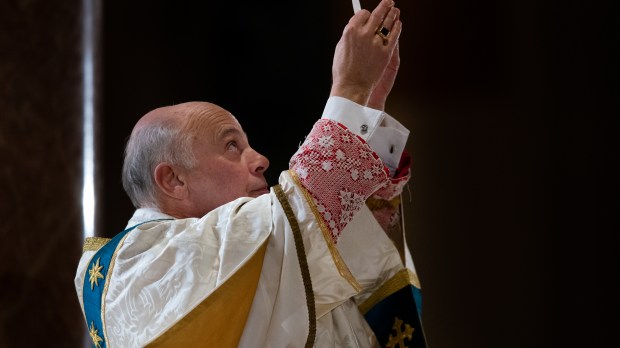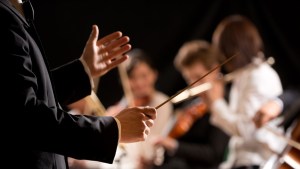Lenten Campaign 2025
This content is free of charge, as are all our articles.
Support us with a donation that is tax-deductible and enable us to continue to reach millions of readers.
From an artist’s perspective, a newly created work of art can be likened to the birth of a baby. An idea is conceived in the mind, consummated through vigorous effort and fertilized and nurtured by deep reflection.
Through a labor of love, an artist gives birth to his “baby.”
When Catholic participants in the Walk for Life West Coast took part in a Mass at the Cathedral of St. Mary of the Assumption in San Francisco in January 2023, a new “baby” was baptized: the first public singing of a musical setting of the Mass, specifically intended to celebrate the gift of life.
The musical setting was commissioned by Archbishop Salvatore Cordileone of San Francisco, who envisioned something written for children’s voices.
The archbishop, who was the spark behind Frank La Rocca’s Mass of the Americas, “wanted a Mass specifically to celebrate the gift of human life,” said Christopher Mueller, composer of the new work. “He wanted a pro-life Mass to be written for children’s voices to heighten the emotionality of the liturgy.”
Mueller is music director at Saint Louis Bertrand Church of the Dominican Friars in Louisville, Kentucky. The rendition of the new Mass featured the choir of St. Brigid School in San Francisco, accompanied by adults. The children sang the four movements of the Ordinary of the Mass as well as a post-Communion reflection and the Alleluia.
The work is sung in English, Spanish, and Latin with a mix of Gregorian chant, Renaissance, and contemporary styles.
Archbishop Cordileone approached Mueller because of his work with the Benedict XVI Institute for Sacred Music and Divine Worship, which Cordileone started several years ago with the mission of “opening the door of Beauty to God.”
In an interview with Catholic San Francisco, the magazine of the archdiocese, Mueller described how his discussions with the archbishop led to the composition of a post-Communion reflection, based on verses from the opening of the Book of Jeremiah, when God told the prophet, “Before I formed you in the womb, I knew you.”
“The beginning of the Book of Jeremiah is a conversation between God and Jeremiah,” Mueller said. “God says, ‘I am giving you this task, to go and be a prophet to the nations … do not say “I am a youth,” for I am with you to deliver you.’”
Adult tenors and basses sing the voice of God in Latin, while children sing Jeremiah’s words in Spanish and English, Catholic San Francisco said. Mueller is a choral composer and conductor, serving as organist and choirmaster at St. Louis Betrand Church. He was the founding director of music at the St. John Paul II National Shrine in Washington, D.C., where he established a program of liturgical music for the daily and Sunday afternoon Masses. He directed the choir and orchestra at the USCCB Convocation of Catholic Leaders, held in 2017 in Orlando, Florida, as well as the choir and orchestra at the Mercy Center at World Youth Day 2016 in Kraków, Poland, where he led the music at daily Mass for 18,000 pilgrims at Tauron Arena. Mueller lives with his wife, Constanza, and three children in Indiana.
Archbishop Cordileone answered a few questions from Aleteia about the new Mass for Life.
What inspired you to commission a Mass for Life?
My original thinking was a Mass “In Celebration of Human Life,” while bearing in mind that the edition of the Roman Missal published for the United States has a special Mass for Various Occasions under the title, “For Giving Thanks to God for the Gift of Human Life.” As it turns out, the Mass will premiere on the Memorial of St. Agnes – a most fitting occasion, as she was a virgin martyr and her name means “lamb.” So I envision the title as, “Mass of St. Agnes in Thanksgiving for Human Life.”
What makes this setting of the Mass unique, while at the same time being faithful to the spirit of the liturgy?
Quite some time ago I foresaw that the Mass preceding the annual Walk for Life – which always falls on the Saturday closest to January 22 – in the year 2023 would be the perfect occasion for commissioning a new Mass of sacred music, as it would be the 50th anniversary of the tragic Roe decision (although I did not anticipate at the time that we would have something to actually celebrate, as it has now been overturned). The massive killing of the unborn for over 50 years cries out to heaven for a special Mass honoring the sacredness of all human life, from conception to natural death.
The idea came to me because we have been commissioning new Masses of sacred music through the Benedict XVI Institute for Sacred Music and Divine Worship with our composer in residence, Frank La Rocca. The idea is to identify major contemporary themes, and use the beauty of sacred music to highlight the issue and unite people around it. But because it is in line with the tradition of polyphony and chant, it also has a quality of timeless beauty to it – at once contemporary and classic. Because Frank was already occupied composing the “Messe des Malades honoring Our Lady of Lourdes” that will be celebrated at Oakland’s Cathedral of Christ the Light on February 11 with the Benedict XVI Choir, the Mass of St. Agnes in Thanksgiving for Human Life is not a Benedict XVI Institute project. But it is an example of the reasons why I founded and support the Benedict XVI Institute so strongly.
Which explains why no one has done – or for that matter, even thought of doing – this before. Sadly, our great sacred music tradition has atrophied in the last half-century. It isn’t the artists’ fault; we have many fine and faithful living sacred music composers, who continue to compose beautiful sacred music. But the Church no longer commissions very much new art. With secular classical music, orchestras continue to perform the great symphonies of the great composers in history, while also performing newly composed works in the classical music genre. Why don’t we do the same with religious classical music? We should! We need great classical sacred music in our liturgies and we need new commissions in the high sacred music tradition on themes spiritually relevant to our times. In Palestrina’s day no one imagined a civilized nation would sanction the killing of children in the womb. That’s why we need new works of sacred music for our times.
Is there a way that this new work might affect people outside an ecclesial setting — a softening of hearts of those who see the life issue differently than we do? Perhaps you have witnessed this already after performances of the Mass of the Americas?
This Mass for Life is written for a children’s choir primarily. What could be more fitting than to bring the voices of the children in to celebrate life? I hope that hearing the innocent voices of children expressing gratitude for life will be a cry for all of us to do more, sacrifice more, and think more about how to support babies in the womb – and their mothers. We love our children; let that love inspire us to face down the horror of abortion and choose life.



